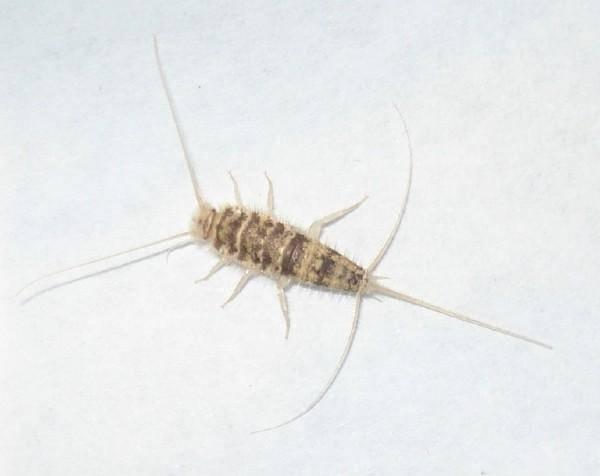About silverfish and firebrats
-
Silverfish and firebrats belong to one of the most primitive groups of insects. They have been identified from fossils dating back over 400 million years.
-
They are often encountered when opening a cupboard or moving an object under which they were hiding.
-
Most silverfish and firebrats are found outdoors but indoors they can become pests because they feed on starchy substances as well as book bindings, dry foods, flour, bits of cloth, or paper.

Firebrat (Thermobia domestica)
Photo: Mohammed El Damir, Bugwood.org
Description and life cycle
-
Silverfish and firebrats are very similar in appearance and are therefore best distinguished by their differences in habitat. Silverfish prefer damp, cool places such as basements, laundry rooms and under sinks. Firebrats, as their name would imply thrive best in very warm, moist places. They are found around ovens, heating units, fireplaces, hot water pipes, the attic in the summer, and near the furnace in winter.
-
Both will readily travel at night throughout the house to sites that suit them best.
-
Silverfish and firebrats have a distinctive fish-like appearance. Their bodies are flat, tapered at both ends, and covered by overlapping scales. They are wingless and small, about 1/2 inch (12.5 mm) in length or less. The antennae are threadlike and very long. They also have three long, thin, tail-like appendages at the end of the abdomen.
-
The maximum lifespan in good conditions is 2 to 3 years.

Typical damage caused by small blue silverfish
Photo: Clemson University - USDA Cooperative Extension Slide Series, Bugwood.org
Damage
-
Silverfish will eat both carbohydrates and proteins. Food sources include dried beef, flour, starch, and stored products such as breakfast cereal. They may also cause serious damage to paper products, eat holes in wallpaper, or eat the paste from under it. Other potential food sources include the starch in book bindings, papers such as onionskin, and cleansing tissues. Newsprint, cardboard, and brown wrapping paper are seldom attacked. They will occasionally attack fabrics. Their preferred fabric is linen, but they may also feed on silks, rayon, and cotton. Damage to fabrics may be recognized by the presence of feces, scales, irregular feeding marks on individual fibers, and in the case of linens, yellowish stains.
Management
-
Clean up any outside hiding source for these pests such as lumber piles, debris, etc. All holes or spaces around pipes should be sealed. Sources of dampness, such as leaky plumbing, or condensation should be eliminated. These provide moisture for the silverfish and firebrats. Kitchens and pantry areas should be thoroughly cleaned and food stored in containers with tight-fitting lids.
-
Silica gel base and boric acid powders are available to manage silverfish and firebrats. Apply directly to cracks and crevices around the door and window casings where the insects enter into homes from outside. They should also be applied under baseboards and sinks, a common hiding place for them during the day. Apply the dust or powder with a plastic squeeze bottle to leave a fine layer of material where it is needed.
Based on publication HG 5 Silverfish and Firebrats, author Mary Kay Malinoski, Principal Agent, University of Maryland Extension (retired). Rev. 2020
